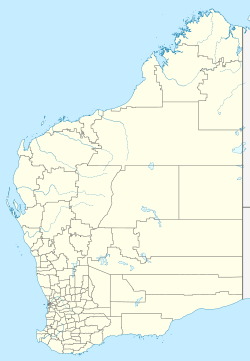Thevenard Island facts for kids
Thevenard Island is a cool island located about 22 kilometers (14 miles) off the coast of Onslow. You can find it in the Pilbara region of Western Australia.
Contents
Discover Thevenard Island
Thevenard Island is the biggest of ten islands and coral reefs known as the Mackerel Islands. Two of these islands, Thevenard Island and Direction Island, have places for tourists to stay.
There's a 1,000-meter (3,281 ft) brick runway on Thevenard. You can get to the island by ferry from Onslow. You can also arrive by boat, helicopter, or a small plane.
Thevenard Island is about 6 kilometers (3.7 miles) long. It covers an area of 550 hectares (1,359 acres). The island is surrounded by limestone reefs. These reefs have many different kinds of coral on the northern side.
The island has deep sandy soil. This soil helps Acacia trees and Triodia grass grow. You can also find coastal heath plants here.
There's a resort on Thevenard Island for visitors. It has places to stay, a small shop, and barbecue areas. There are also boat moorings, an airstrip, and fuel. The island gets its fresh water from a solar power and desalination plant. Fun things to do include fishing, diving, and snorkelling.
Amazing Animals of Thevenard Island
Thevenard Island is a special "C class nature reserve." This means it's a protected area for wildlife. Many amazing animals live here or visit the island.
Sea Turtles and Their Reproduction
Between November and March, several types of sea turtles come to the beaches. They lay their eggs here. These include green sea turtles, flatback sea turtles, loggerhead sea turtles, and hawksbill sea turtles.
Dolphins and Whales
The waters around the island are home to many dolphins. You might see bottlenose, spinner, striped, common, and humpback dolphins.
Large Whales also visit this area. These include pilot whales, false killer whales, sei whales, bryde’s whales, and humpback whales. Humpback whales travel south from June to October. Baby whales are born in August.
Dugongs (Sea Cows)
Dugongs, also called sea cows, live in the waters around the island. You can often see them eating and having their babies in water less than 5 meters (16 ft) deep. Dugong breeding happens between September and April.
Birds and Reptiles
Twenty-four types of land birds have been seen on Thevenard Island. Also, up to 31 types of migratory birds visit the Mackerel Islands area. These birds include kestrels, quails, godwits, plovers, sandpipers, and harriers. Some birds fly all the way from places like Siberia. They are protected by special international agreements. Seabirds, like terns and shearwaters, build their nests from October to January.
Nine types of reptiles have been found on the island. These include goannas, dragons, skinks, geckos, and ta-ta lizards. No rare or endangered reptiles live here.
Mammals
The only native land mammal on the island is the endangered forrest's mouse. This mouse is also called the short-tailed mouse. Regular domestic mice also live on the island. They were likely brought there by people.
History of Thevenard Island
Indigenous Australians visited Thevenard Island a very long time ago. They were there before and after the island separated from the mainland. This happened about 8,000 years ago.
Tourism Development
In 1964, two local people, Ian Blair and Adrian Day, were given permission to use Thevenard Island and Direction Island. This was by the Government of Western Australia. In 1973, a group of local farmers bought the business.
Over time, the simple beach shacks used by fishermen grew into a full tourism business. In 1997, the same group of farmers also built the Onslow Mackerel Motel on the mainland.
Oil and Gas Discoveries
In 1985, a company called WAPET found oil near Thevenard Island. This was called the Saladin oil field. More oil and gas fields were found later. These led to big projects like the North West Shelf Project and the Gorgon project.
WAPET was allowed to build oil production facilities on Thevenard Island. The first oil was produced from this project in 1989. More fields started producing oil between 1991 and 1998. They used facilities both offshore and on Thevenard Island itself.
In 2000, Chevron Australia took over the oil and gas operations. Oil production from the offshore fields, including Saladin, stopped in 2014. Chevron tried to sell the facilities on Thevenard Island but couldn't. So, in 2015, they decided to remove everything from the site. This included all the buildings, roads, and foundations.
The Mackerel Islands company, which runs the tourism business, said in 2017 that the oil and gas facilities would be removed. This would allow them to focus on developing eco-tourism on Thevenard Island.
Shipwreck
In 1994, a ship called the MV Boa Force crashed near the island. It hit an oil wellhead. All eleven crew members were saved. The ship was later lifted out of the water and then sunk in deep water.
Helping Our Turtles: The Monitoring Project
The Government of Western Australia's Department of Parks and Wildlife (now called the Department of Biodiversity, Conservation and Attractions) started a project in 2016. They wanted to watch the flatback turtles on Thevenard Island. This project continues every year.
Thevenard Island is an important place for turtles to lay their eggs. This project helps scientists understand more about the flatback turtles. It helps them learn about how many turtles there are and where they live.
Flatback turtles are listed as "vulnerable" in Western Australia. This means they need protection. Around the world, we need more research to know exactly how many there are.
The North West Shelf Flatback Conservation Program helps fund this work. It's a big program that helps protect these turtles.


